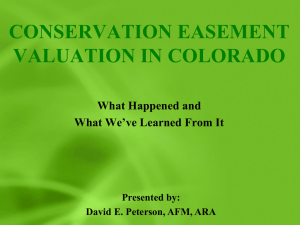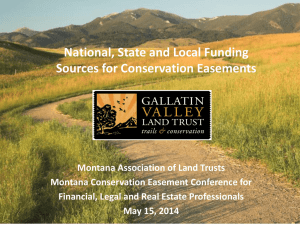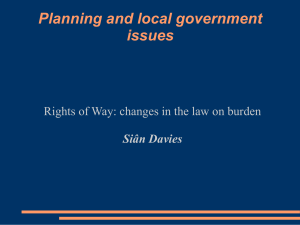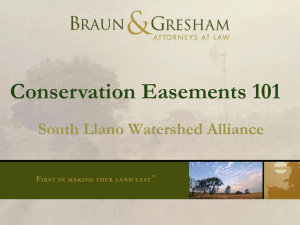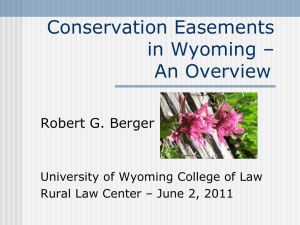CONSERVATION EASEMENTS: TAX BENEFITS and CURRENT
advertisement
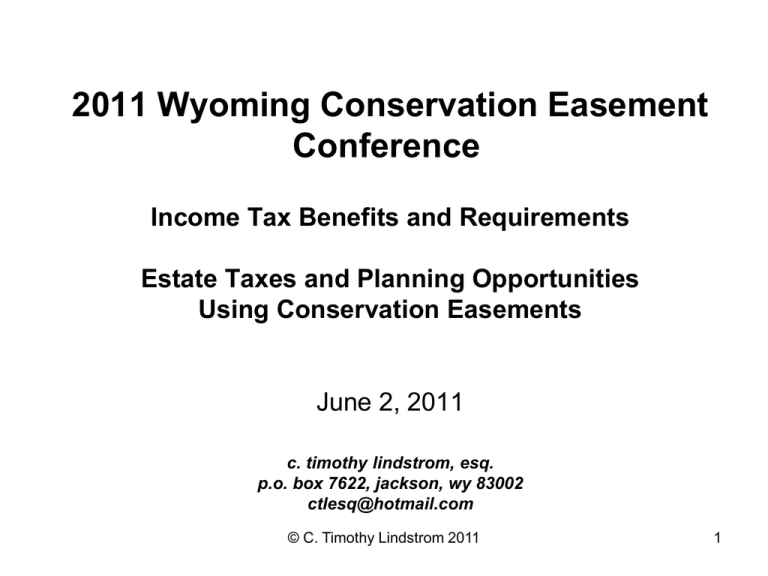
2011 Wyoming Conservation Easement Conference Income Tax Benefits and Requirements Estate Taxes and Planning Opportunities Using Conservation Easements June 2, 2011 c. timothy lindstrom, esq. p.o. box 7622, jackson, wy 83002 ctlesq@hotmail.com © C. Timothy Lindstrom 2011 1 IRS Activity • Currently 344 easement audits open; including 84 in CO • 2005-2009 Closed audits on 1,115 easement cases; including 418 in CO • 3,500 to 4,000 easement contributions per year • Chances of audit +/- 5% based on foregoing (outside of CO) • Fifteen judicial decisions regarding easement tax compliance since 2005 Land Trust Alliance (2010) © C. Timothy Lindstrom 2011 2 IRS Scorecard (twelve out of fifteen) Glass v. C.I.R. 124 T.C. 258 (2005) Lost Turner v. C.I.R. 126 T.C. 299 (2006) Won Goldsby v. C.I.R. T.C. Memo. 2006-274 (2006) Won Bruzewicz v. U.S. 604 F.Supp.2d 1197 (2009) Won Hughes v. C.I.R. T.C. Memo. 2009-94 (2009) Won Kiva Dunes v. C.I.R. T.C. Memo. 2009-145 (2009) Lost Herman v. C.I.R. T.C. Memo. 2009-205 (2009) Won Simmons v. C.I.R. T.C. Memo. 2009-208 (2009) Won Lord v. C.I.R. T.C. Memo. 2010-196 (2010) Won Klauer v. C.I.R. T.C. Memo 2010-65 (2010) Lost Kaufman v. C.I.R. 134 T.C. 6 (2010) Won Trout Ranch v. C.I.R. T.C. Memo 2010-283 (2010) Won Schrimsher v. C.I.R. T.C. Memo 2011-71 (2011) Won 1982 East, LLC V. C.I.R. T.C. Memo 2011-84 (2011) Won Boltar v. C.I.R. 136 T.C. No. 14 (2011) Won © C. Timothy Lindstrom 2011 3 To be deductible conservation easements must comply with: • Internal Revenue Code section 170(h) • Treasury Regulations section 1.170A-14 • Wyoming Uniform Conservation Easement Act: W.S. Sections 34-1-201 through 34-1-207 © C. Timothy Lindstrom 2011 4 The “Partial Interest Rule” A deduction under section 170 is generally not allowed for a charitable contribution of any interest in property that consists of less than the donor's entire interest in the property. . . Regulations section 1.170A-14(a); txt 15-16, 23-24, 77 © C. Timothy Lindstrom 2011 5 Exceptions to the Partial Interest Rule Certain gifts in trust Remainder interest in personal residence or farm All of the donor’s undivided interest in property A “Qualified conservation contribution” “. . . a deduction may be allowed under section 170(f)(3)(B)(iii) for the value of a qualified conservation contribution if the requirements of this section are met.” Regulations section 1.170A-14(a); txt 15-16, 23-24, 77 © C. Timothy Lindstrom 2011 6 Qualified Conservation Contributions • Contribution (includes “bargain sales”) of: • A qualified real property interest • To a qualified organization • Exclusively for conservation purposes • In perpetuity Regulations section 1.170A-14(a); txt chapter 3 © C. Timothy Lindstrom 2011 7 Qualified Real Property Interests -- The entire interest of the donor other than a “qualified mineral interest” A qualified mineral interest is the donor's interest in subsurface oil, gas, or other minerals and the right of access to such minerals. Regulations section 1.170A-14(b)(1) -- A remainder interest in a farm or personal residence Code section 170(h)(2)(B) [not found in Regulations] -- A “perpetual conservation restriction” Regulations section 1.170A-14(b)(2); txt 25-28 © C. Timothy Lindstrom 2011 8 Perpetual Conservation Restriction • A restriction, in perpetuity, on use of real property including an easement or other interest in real property that under state law has attributes similar to an easement (e.g., a restrictive covenant or equitable servitude) Regulations section 1.170A-14(b)(2) © C. Timothy Lindstrom 2011 9 Importance of State Law • State real property law governs the creation, modification and termination of conservation easements; therefore: • Failure to create a perpetual restriction on the use of real property under state law may disqualify easement for federal tax benefits. Conservation easements are “easements in gross” because they do not benefit any specific property (i.e. they are not “appurtenant”) Generally, under common law, easements in gross were unenforceable. Enabling legislation has been enacted in 49 states recognizing conservation easements and pre-empting common law. • All states except North Dakota have enacted some form of authority for the creation and enforcement of perpetual conservation easements. © C. Timothy Lindstrom 2011 10 Qualified Conservation Contributions • Contribution (includes “bargain sales”) of: • A qualified real property interest • To a qualified organization • Exclusively for conservation purposes • In perpetuity Regulations section 1.170A-14(a) © C. Timothy Lindstrom 2011 11 Qualified Organizations • Qualified Organizations include: • Publicly supported tax-exempt organizations recognized by the IRS under Code sections 501(c)(3) and 170(b)(1)(A)(vi) (“land trusts”) • Public agencies • Governmentally-affiliated organizations Regulations section 1.170A-14(c)(1); txt 28-34 • Transfers must be limited to “qualified organizations” agreeing to carry out the conservation purposes of the easement. Regulations section 1.170A-14(c)(2); txt 39 © C. Timothy Lindstrom 2011 12 Qualified Organizations (cont.) • A “qualified organization” must have • a commitment to protect the conservation purposes of the donation, and • the resources to enforce the restrictions. Regulations section 1.170A-14(c)(1); txt 34-35; 37-38 • LTA Standards and Practices • Accreditation Txt 38 • Land Trust Alliance: www.lta.org © C. Timothy Lindstrom 2011 13 Qualified Conservation Contribution • Contribution (includes “bargain sales”) of: • A qualified real property interest • To a qualified organization • Exclusively for conservation purposes • In perpetuity Regulations sections 1.170A-14(d)(1) – (5); txt 39-60 © C. Timothy Lindstrom 2011 14 Qualified Conservation Purposes: 1. Public Recreation/ Education 2. Protection of significant, relatively natural habitat for plants or animals 3. Protection of historic structures or land areas Regulations sections 1.170A-14(d)(1) – (5); txt 39-60 © C. Timothy Lindstrom 2011 15 Qualified Conservation Purposes (cont.): 4. Protection of open space a. For scenic purposes and/ or b. Pursuant to a clearly delineated governmental conservation policy c. Resulting in a significant public benefit Regulations sections 1.170A-14(d)(1) – (5); txt 39-60 © C. Timothy Lindstrom 2011 16 Two types of inconsistent use prohibitions • Inconsistent Use prohibition applicable to “open space” easements: • “A deduction will not be allowed for the preservation of open space under section 170(h)(4)(A)(iii), if the terms of the easement permit a degree of intrusion or future development that would interfere with the essential scenic quality of the land or with the governmental conservation policy that is being furthered by the donation.” Regulations section 1.170A-14(d)(4)(v) (emphasis added); txt 74-76 © C. Timothy Lindstrom 2011 17 General inconsistent use prohibition • Inconsistent use. Except as provided in paragraph (e)(4) of this section, a deduction will not be allowed if the contribution would accomplish one of the enumerated conservation purposes but would permit destruction of other significant conservation interests. However, this requirement is not intended to prohibit uses of the property, such as selective timber harvesting or selective farming if, under the circumstances, those uses do not impair significant conservation interests. Regulations sections 1.170A-14(e)(2) and (3)(emphasis added); txt 71-74 © C. Timothy Lindstrom 2011 18 Inconsistent Uses (cont.) • Example, the preservation of farmland pursuant to a State program for flood prevention and control would not qualify under paragraph (d)(4) of this section if under the terms of the contribution a significant naturally occurring ecosystem could be injured or destroyed by the use of pesticides in the operation of the farm. Regulations sections 1.170A-14(e)(2) © C. Timothy Lindstrom 2011 19 Sample inconsistent use provision • The “Conservation Purposes” of this Easement are (i) to preserve the Conservation Values, and other significant conservation interests (to the extent that it is not necessary to impair such other interests in order to protect the Conservation Values), and (ii) to restrict the use of the Property to those uses that are consistent with such values and interests. © C. Timothy Lindstrom 2011 20 Sample Inconsistent Use Provision 2 Reserved Uses: The following uses, properly undertaken, are consistent with the Conservation Purposes, and are reserved by the Grantor, subject to the condition that such uses are undertaken in a manner that is consistent with the Conservation Purposes: © C. Timothy Lindstrom 2011 21 Qualified Conservation Contribution The Contribution (includes “bargain sales”) of: • A qualified real property interest • To a qualified organization • Exclusively for conservation purposes • In perpetuity Regulations section 1.170A-14(a); txt 61-71 © C. Timothy Lindstrom 2011 22 Perpetuity • Amendment and Termination (txt 64-70) • Contract vs. Charitable Trust (txt 4, 64, 89-90) “§ 2. Creation, Conveyance, Acceptance and Duration. (a) Except as otherwise provided in this Act, a conservation easement may be created, conveyed, recorded, assigned, released, modified, terminated, or otherwise altered or affected in the same manner as other easements.” [Emphasis added.] Uniform Conservation Easement Act §2(a) (txt Appendix C) © C. Timothy Lindstrom 2011 23 “because conservation easements are conveyed to governmental bodies and charitable organizations to be held and enforced for a specific public or charitable purpose -- i.e., the protection of the land encumbered by the easement for one or more conservation or preservation purposes -- the existing case and statute law of adopting states as it relates to the enforcement of charitable trusts should apply to conservation easements.” Uniform Conservation Easement Act comment to §3 (emphasis added) © C. Timothy Lindstrom 2011 24 Wyoming Uniform Conservation Easement Act § 34-1-202. Creation; conveyance; acceptance and duration (a) Except as otherwise provided in this article, a conservation easement may be created, conveyed, recorded, assigned, released, modified, terminated or otherwise altered or affected in the same manner as other easements. The provisions of W.S. 34-1-141 [governing description of easement location] shall apply to this article. [Emphasis added.] § 34-1-203. Judicial action; modification; termination (a) An action affecting a conservation easement may be brought by: (i) An owner of an interest in the real property burdened by the conservation easement; (ii) A holder of the conservation easement; (iii) A person having third-party rights of enforcement, as named in the instrument creating the conservation easement. (b) This article shall not affect the power of a court to modify or terminate a conservation easement in accordance with the principles of law and equity. © C. Timothy Lindstrom 2011 25 Wyoming Law Regarding Charitable Trusts • In the absence of special provisions in the trust instrument, the trustees have no power of their own motion to decide that it has become impossible or inexpedient to carry out the trust as originally planned and then to substitute another scheme. If the trustees feel that an emergency of this type has arisen, they should bring the situation to the attention of the court and ask for instructions. [Emphasis added]. • Town of Cody v. Buffalo Bill Memorial Association, 196 P.2d 369 (Wyo. 1948) [quoting 2 Bogert, Trusts and Trustees § 435] © C. Timothy Lindstrom 2011 26 Charitable Trust Doctrine -- Conservation Easements A conservation easement may only be amended or terminated if: 1. Such a power is expressly reserved in the easement itself; 2. a court applies the doctrine of “administrative deviation” to alter a provision that would defeat or substantially impair the conservation purposes of the easement; or © C. Timothy Lindstrom 2011 27 Charitable Trust Doctrine -- Conservation Easements (cont.) 3. the charitable purpose of the easement is impossible to accomplish due to changed circumstances and a court, through the doctrine of cy pres authorizes a revision or termination. Paraphrasing Nancy A. McLaughlin, Rethinking the Perpetual Nature of Conservation Easements, 29 Harv. Int’l L.J. 421, 435–436 (2005) © C. Timothy Lindstrom 2011 28 Federal Requirements Pertaining to Amendment and Termination None of the assets of a land trust may “inure” to the benefit of any “disqualified person” (“excess benefit transactions”). Internal Revenue Code section 501(c)(3); txt 65-66 -- A disqualified person is anyone in a period beginning five years before a transaction in a position to exert “substantial influence.” -- Board members, staff, “substantial contributors” more than 2% of the land trust’s annual receipts, or $5,000, whichever is greater (may include easement value). © C. Timothy Lindstrom 2011 29 Federal Requirements Pertaining to Amendment and Termination (cont.) Consequences: -- Excise tax of 25% plus repayment of benefit -- Up to $10,000 penalty on land trust managers -- Loss of exempt status Regulations section 53.4958-7; txt 65-66 © C. Timothy Lindstrom 2011 30 Federal Requirements Pertaining to Amendment and Termination (cont.) • A land trust’s assets must be used “exclusively” for charitable purposes Internal Revenue Code section 501(c)(3); txt 66-67 • A land trust must have a “commitment to protect the conservation purposes of the contribution. Internal Revenue Code section 170(h)(3); txt 67-68 © C. Timothy Lindstrom 2011 31 Other Regulatory Requirements: • Documentation (available prior to grant) (txt 83-85) • Donee's right to inspection (txt 86) • Donee’s right “to enforce the conservation restrictions by appropriate legal proceedings, including but not limited to, the right to require the restoration of the property to its condition at the time of the donation.” (txt 86-88) • Landowner must give notice before exercising any reserved rights that may impair the conservation interests protected by the easement. (txt 85) Regulations sections 1.170A-14(g)(5)(i) and (ii) © C. Timothy Lindstrom 2011 32 Other Regulatory Requirements (con’t.) • Mortgages must be subordinated Regulations section 1.170A-14(g)(2); txt 70-71 • Payment of proceeds in event of of extinguishment “. . .when a change in conditions give rise to the extinguishment of a perpetual conservation restriction under paragraph (g)(6)(i) of this section, the donee organization, on a subsequent sale, exchange, or involuntary conversion of the subject property, must be entitled to a portion of the proceeds at least equal to that proportionate value of the perpetual conservation restriction. . .” Regulations section 1.170A-14(g)(6)(ii); txt 91-99 © C. Timothy Lindstrom 2011 33 Mortgage Subordination Requirement Kaufman v. Commissioner, 134 T.C. 6 (4/26/10); 1982 East, LLC v. Commissioner, T.C. Memo 2011-84 (4/12/11) rule that conditional subordinations are not acceptable. Lender “shall have a prior claim to all insurance proceeds as a result of any casualty, hazard or accident occurring to or about the Property and all proceeds of condemnation, and shall be entitled to same in preference to Grantee until the Mortgage is paid off and discharged, notwithstanding that the Mortgage is subordinate in priority to the Agreement.” What about other matters of title that could pre-empt a conservation easement, e.g. covenants with reversionary provisions? © C. Timothy Lindstrom 2011 34 Acceptable Subordination Forms • [Name and address of financial institution] (“Mortgagee”), present holder of a mortgage from, [donors] (“Mortgagor”), recorded on [date] in the [County] Registry of Deeds in Deed Book [ ] Page [ ], for consideration paid, hereby recognizes and assents to the terms and provisions of a Conservation Restriction running to the Conservation Trust, to be recorded herewith, and agrees to subordinate and hold its mortgage subject to the terms and provisions of said Conservation Restriction to the same extent as if said mortgage had been recorded subsequent to the recording of the Conservation Restriction, and the undersigned shall, in the exercise of its rights pursuant to said instrument, recognize the terms and provisions of the aforesaid Conservation Restriction. Compact of Cape Cod Conservation Trusts Form • The Lender hereby consents to the terms and intent of this Easement, and agrees that the lien represented by said Deed of Trust shall be held subject-to this Easement and joins in this Deed to reflect its direction to the Trustee to execute this Easement to giveeffect to the subordination of such Deed of Trust to this Easement. Virginia Outdoors Foundation Form © C. Timothy Lindstrom 2011 35 Minerals • Deductible easements must prohibit strip mining • Other forms of mining and mineral extraction must be “limited” “localized” and “not irremediably destructive of significant conservation values” Regulations section 1.170A-14(g)(4); txt 25, 77–83 © C. Timothy Lindstrom 2011 36 Mineral Issues: • Gravel pits • Subsurface minerals • Severed minerals and easement deductions • Federal plans for BLM and other federal lands • “Carve-out” provisions • “Remoteness letter” Txt 76-85 © C. Timothy Lindstrom 2011 37 Donative Intent Conservation buyer transactions (txt 123-128) Quid pro quo transactions (txt 118-119) Cluster developments (txt 119-120) Grants requiring easements Reciprocal contributions (txt 121-122) Qualified bargain sales (txt 6, 116-117) Sham (“collapsible”) transactions (txt 18-19) See U.S. v. American Bar Endowment, 477 U.S. 105, 106 S.Ct. 2426, 91 L.Ed.2d 89 (1986); txt 1617, 115-116 © C. Timothy Lindstrom 2011 38 Income Tax Benefits Easement Valuation • Value of land before c.e. $1,000,000 • Value of land after c.e. (700,000) • Difference = c.e. value $ 300,000 Regulations § 1.1170A-14(h)(3) © C. Timothy Lindstrom 2011 39 Calculating the Federal Income Tax Benefit 2011 Maximum benefit: Before c.e. value of land $1,000,000 After c.e. value of land C.e. value (700,000) $ Maximum federal income tax rate Maximum federal income tax savings © C. Timothy Lindstrom 2011 300,000 x 0.35 $ 105,000 40 Limitation on deductions: 2011 50% of “contribution base” (AGI) if donor’s farm income is less than 50% of all income Internal Revenue Code §§ 170(b)(1)(E)(i) and 170(b)(1)(E)(vi). 100% of contribution base if donor’s farm income is 50% or more of all income Internal Revenue Code §§ 170(b)(1)(E)(iv)(I) and 170(b)(1)(E)(vi). [Note that proceeds from the sale of a conservation easement are not “income from the business of farming”] 2012 30% of contribution base after 12/31/11 Internal Revenue Code §§ 170(b)(1)(C) and 170(b)(1)(E)(vi). © C. Timothy Lindstrom 2011 41 Carrying deductions forward: 2011 Unused portions of deduction may be carried forward for fifteen years Internal Revenue Code §§ 170(b)(1)(E)(ii) and 170(b)(1)(E)(vi). 2012 Unused portions of deduction may be carried forward for five years Internal Revenue Code §§ 170(b)(1)(D)(ii) and 170(b)(1)(E)(vi). “Phasing” contributions © C. Timothy Lindstrom 2011 42 Calculating the Federal Income Tax Benefit - 2011 Assume: Married filing jointly Donor income $250,000 Other contributions $50,000 Other deductions $50,000 Conservation easement deduction $500,000 Maximum charitable deduction allowed $125,000 ($500,000 x 50%) Deduction available $75,000 ($125,000 - $50,000) Taxable income prior to easement deduction $150,000 ($250,000 – $100,000) Rate on income between $75,000 and $150,000 ($64,500 @ 25%; $10,500 @ 28%) Tax savings in first year due to easement: $19,065 (25.42%) Cumulative savings over 7 years $127,101 (25.42%) © C. Timothy Lindstrom 2011 43 Example of Operation of Current Limitations (2011) • • • • • • C.e. value Donor’s annual income Annual limitation Annual cap on c.e. deduction Sixteen-year deduction period Total deduction cap • • Amount of deduction unusable $0.00 (50% level) Amount of deduction unusable $0.00 (100% level) $ $ 300,000 54,000 x 50% $ 27,000 x 16 $ 432,000 Example of Operation of Future Limitations (2012) • • • • • • C.e. value Donor’s annual income Annual limitation Annual cap on c.e. deduction Six-year deduction period Total deduction cap • Amount of deduction unusable $ 202,800 © C. Timothy Lindstrom 2011 $ 300,000 $ 54,000 x 30% $ 16,200 x 6 $ 97,200 44 Application of enhanced write-off to fee contributions Contributions of qualified conservation contributions (i) In general Any qualified conservation contribution (as defined in subsection (h)(1)) shall be allowed to the extent the aggregate of such contributions does not exceed the excess of 50 percent of the taxpayer's contribution base over the amount of all other charitable contributions allowable under this paragraph. (ii) Carryover If the aggregate amount of contributions described in clause (i) exceeds the limitation of clause (i), such excess shall be treated (in a manner consistent with the rules of subsection (d)(1)) as a charitable contribution to which clause (i) applies in each of the 15 succeeding years in order of time. Internal Revenue Code §170(b)(1)(E) (h) Qualified conservation contribution (1) In general For purposes of subsection (f)(3)(B)(iii), the term "qualified conservation contribution" means a contribution- (A) of a qualified real property interest, (B) to a qualified organization, (C) exclusively for conservation purposes. Internal Revenue Code §170(h)(1) © C. Timothy Lindstrom 2011 45 Basis Issues • Calculating the basis in a conservation easement • Adjusting the basis of easement land for the grant of an easement • Enhancement vs. larger parcel affect on basis • Allocation of adjusted basis in 1031 exchanges © C. Timothy Lindstrom 2011 46 Basis Issues (cont.) Calculating Basis in Conservation Easements • Needed for completing form 8283 • Needed to determine limitation on first year contributions • Needed for other basis determinations © C. Timothy Lindstrom 2011 47 Calculating Basis in Conservation Easements (cont.) • Example: Appraised highest and best use before easement: $750,000 Appraised highest and best use after easement: $250,000 Easement value: $500,000 Percentage reduction due to easement ($500k/$750k): 67% Original basis in easement property: $100,000 Basis in easement (67% x $100k): $ 67,000 © C. Timothy Lindstrom 2011 48 Basis Issues (cont.) Basis Adjustment for Contribution Assume: 25% (Percentage of appraised “before” value represented by easement) $100,000 (Unadjusted basis in easement land) Basis adjustment: $100,000 – (25% x $100,000) = $75,000 Additional amount subject to gain on sale of easement land: $25,000 ($100,000 - $75,000) Additional tax if easement land sold: = $3,750 (15% x $25,000) Regulations §1.170A-14(h)(3)(iii) © C. Timothy Lindstrom 2011 49 Basis Issues (cont.) Like-kind exchange example • Taxpayer bargain sells conservation easement for $200,000. • Easement value is $500,000. • Deduction = $300,000 ($500,000 – $200,000) • Percentage of easement value = to purchase price 40% ($200,000/$500,000) • Basis in easement property $50,000. • Appraised f.m.v. of easement property before easement = $900,000 • % of f.m.v. equal to easement 56% ($500,000/$900,000) • Basis in easement $28,000 (56% x $50,000) • Basis carried over to exchange property $11,200 ($28,000 x 40%) © C. Timothy Lindstrom 2011 50 Appraisal Issues Attorney Client Privilege and Appraisals Conservation easement appraisal work done by appraiser as consultant to an attorney representing easement donor is not entitled to the attorney client privilege or the work product privilege because (1) the consultant was not communicating about legal matters and (2) the work product was not prepared because of anticipated litigation but rather to satisfy federal requirements for substantiation of the easement donation. U.S. v. Richey, No. 09-35462, 9th Circuit Court of Appeals, (2011) © C. Timothy Lindstrom 2011 51 Appraisal Issues (cont.) Contiguous (“Larger”) Parcel Rule “The amount of the deduction in the case of a charitable contribution of a perpetual conservation restriction covering a portion of the contiguous property owned by a donor and the donor's family (as defined in section 267(c)(4)) is the difference between the fair market value of the entire contiguous parcel of property before and after the granting of the restriction.” Regulations § 1.1170A-14(h)(3)(i) “The family of an individual shall include only his brothers and sisters (whether by the whole or half blood), spouse, ancestors, and lineal descendants . . .” Internal Revenue Code §267(c)(4) © C. Timothy Lindstrom 2011 52 Appraisal Issues (cont.) Enhancement Rule “If the granting of a perpetual conservation restriction after January 14, 1986, has the effect of increasing the value of any other property owned by the donor or a related person, the amount of the deduction for the conservation contribution shall be reduced by the amount of the increase in the value of the other property, whether or not such property is contiguous.” Internal Revenue Code §267(c)(4) © C. Timothy Lindstrom 2011 53 Appraisal Issues (cont.) Effect of Contiguous Parcel Rule on Basis Contiguous Parcel (200 acres under easement, 50 acres unrestricted): Property basis: $200,000 Appraised “before value” including all contiguous property: $750,000 Appraised “after value” including all contiguous property: $200,000 Easement value: $550,000 Deduction: $550,000 Reduction in property basis required: 73.3% ($550,000/ $750,000) Adjusted basis to reflect contribution: $53,340 [$200,000 – (73.3% x $200,000] © C. Timothy Lindstrom 2011 54 Appraisal Issues (cont.) Effect of Enhancement Rule on Basis Easement Parcel (200 acres) Enhanced Parcel (50 acres) Easement Parcel basis: $200,000 Appraised “before value” of Easement Parcel: $750,000 Appraised “after value” of Easement Parcel: $100,000 Easement value: $650,000 Value of Enhanced Parcel before easement: $100,000 Value of Enhanced Parcel after easement: $200,000 Deduction: $550,000 Reduction in property basis required: 86.7% ($650,000/ $750,000) Adjusted basis to reflect contribution: $26,600 [$200,000 – (86.7% x $200,000] © C. Timothy Lindstrom 2011 55 Appraisal Issues (cont.) Comparison Contiguous Parcel: Easement value is $550,00 Deduction is $550,000 Basis adjustment required ($146,600) Enhancement: Easement value is $650,00 Subtraction for enhancement: $100,000 Deduction is $550,000 Basis adjustment required ($173,400) © C. Timothy Lindstrom 2011 56 Example: Appraisal Issues (cont.) Use of Percentages Before value of easement property determined by comparable analysis: $800,000 Average reduction in value of properties subject to comparable easements: 70% Diminution factor: 70% After value of easement property: $240,000 [$800,000 – ($800,000 x 70%)] Easement value: $560,000 © C. Timothy Lindstrom 2011 57 Appraisal Issues (cont.) Use of Percentages Johnston v. C.I.R. T.C. Memo. 1997-475 (allowed) Strasburg v. C.I.R., T.C. Memo 2000-94 (2000) (rejected) Nick R. Hughes v. Commissioner, T.C. Memo. 2009-94 (2009) (rejected) Bruzewicz v. C.I.R. 604 F.Supp.2d 1197 (N.D. Illinois, 2009) (criticized) Simmons v. C.I.R. T.C. Memo. 2009-208 (2009) (allowed) Scheidelman v. C.I.R. TC Memo 2010-151 (2010) (criticized) IRS Chief Counsel Advisory, IRS CCA 2007 38013 (rejected) Instructions to Form 8283 (rejected) © C. Timothy Lindstrom 2011 58 Issues for Corporations and Other Entities C corporations Charitable deductions limited to 10% of “taxable” income Five-year carry-forward period No capital gains rate © C. Timothy Lindstrom 2011 59 Issues for Corporations and Other Entities (cont.) In 2011 100% write-off available for C corporations if more than 50% of income is from the “business of farming” and Stock not listed on any recognized market Internal Revenue Code §170(b)(2)(i) © C. Timothy Lindstrom 2011 60 Issues for Corporations and Other Entities (cont.) S corporations Charitable deductions pass-through to shareholders prorata Shareholders may deduct no more than their basis in their shares Shareholders’ unused deductions carry-forward for fifteen years and may be used against 50% of shareholders’ AGI Internal Revenue Code §1366(d) © C. Timothy Lindstrom 2011 61 Issues for Corporations and Other Entities (cont.) In 2011: Unlimited pass-through for gain portion of easement contribution. Basis portion of contribution limited to shareholder basis in shares. Internal Revenue Code §1367(a)(2) © C. Timothy Lindstrom 2011 62 Example of S-corp Pass-through Rules S-corp contributes conservation easement worth $500,000 Two equal shareholders. John holds 25% of the shares with a $10,000 basis; Jane holds 75% of the shares with a $50,000 basis. S-corp basis in land subject to easement $200,000. Appraised fair market value of land before easement $1,000,000 Basis in conservation easement $100,000 [($500,000/$1,000,000) x $200,000] Portion of conservation easement constituting gain $400,000 ($500,000 - $100,000) or 80% John’s share of easement deduction $125,000 (25% x $500,000) Jane’s share of easement deduction $375,000 (75% x $500,000) © C. Timothy Lindstrom 2011 63 Example of S-corp Pass-through Rules (cont.) Portion of John’s share constituting basis $25,000 ($125,000 x 20%) Portion of John’s share constituting gain $100,000 ($125,000 - $25,000) Portion of Jane’s share constituting basis $75,000 ($375,000 x 20%) Portion of Jane’s share constituting gain $300,000 ($375,000 - $75,000) John’s pass-through in first year $110,000 ($100,000 + $10,000) Jane’s pass-through in first year $350,000 ($300,000 + $50,000) © C. Timothy Lindstrom 2011 64 Example of S-corp Pass-through Rules (cont.) • In 2012 – Amount of deduction passing to John is $10,000. – Amount of deduction passing to Jane is $50,000. – Balance may be passed through over the next five years provided that John and Jane establish a new basis in their shares. © C. Timothy Lindstrom 2011 65 Issues for Corporations and Other Entities (cont.) Trusts Grantor trusts – ignored for purposes of taxation; i.e. the owner of the trust is treated as the recipient of all income and deductions (including charitable deductions) of the trust. Internal Revenue Code §671 To ensure that contribution or bargain sale of a conservation easement by a grantor trust is effective the trust instrument should expressly authorize the trustee to make charitable contributions in general, or contributions of conservation easements in specific. QPRT Trusts – QPRT trusts are grantor trusts. However, regulations prohibit the distribution of any income or corpus of the trust to or for the benefit of anyone other than the transferor prior to the termination of the trust. Regulations §25.2702-5(c)(4) Irrevocable Trusts – Contributions of conservation easements by irrevocable trusts are not deductible by the trust because they are not payments from income, but from corpus and they do not pass through to beneficiaries because they are not owners. See Goldsby v. C.I.R., T.C. Memo. 2006-274 (2006) © C. Timothy Lindstrom 2011 66 Substantiation Requirements – Acknowledgment Letter • “General rule No deduction shall be allowed under subsection (a) for any contribution of $250 or more unless the taxpayer substantiates the contribution by a contemporaneous written acknowledgment of the contribution by the donee organization that meets the requirements of subparagraph (B).” Internal Revenue Code §170(f)(8)(A) • “Content of acknowledgement: An acknowledgement meets the requirements of this subparagraph if it includes the following information: “(i) The amount of cash and a description (but not value) of any property other than cash contributed. “(ii) Whether the donee organization provided any goods or services in consideration, in whole or in part, for any property described in clause (i). “(iii) A description and good faith estimate of the value of any goods or services referred to in clause (ii) or, if such goods or services consist solely of intangible religious benefits, a statement to that effect. For purposes of this subparagraph, the term "intangible religious benefit" means any intangible religious benefit which is provided by an organization organized exclusively for religious purposes and which generally is not sold in a commercial transaction outside the donative context.” Internal Revenue Code §170(f)(8)(B) © C. Timothy Lindstrom 2011 67 Substantiation Requirements – Acknowledgment Letter (cont.) “Contemporaneous: For purposes of subparagraph (A), an acknowledgment shall be considered to be contemporaneous if the taxpayer obtains the acknowledgment on or before the earlier of“(i) the date on which the taxpayer files a return for the taxable year in which the contribution was made, or “(ii) the due date (including extensions) for filing such return. Internal Revenue Code §170(f)(8)(c) © C. Timothy Lindstrom 2011 68 Substantiation Requirements -- Appraisal • Donor must obtain a qualified appraisal of the easement (A) A description of the property in sufficient detail for a person who is not generally familiar with the type of property to ascertain that the property that was appraised is the property that was (or will be) contributed; *** (C) The date (or expected date) of contribution to the donee; (D) The terms of any agreement or understanding entered into (or expected to be entered into) by or on behalf of the donor or donee that relates to the use, sale, or other disposition of the property contributed . . . *** E) The name, address and (if a taxpayer identification number is otherwise required by section 6109 and the regulations thereunder) the identifying number of the qualified appraiser; and, if the qualified appraiser is acting in his or her capacity as a partner in a partnership, an employee of any person (whether an individual, corporation, or partnerships), or and independent contractor engaged by a person other than the donor, the name, address, and taxpayer identification number (if a number is otherwise required by section 6109 and the regulations thereunder) of the partnership or the person who employs or engages the qualified appraiser; © C. Timothy Lindstrom 2011 69 Substantiation Requirements – Appraisal (cont.) • (F) The qualifications of the qualified appraiser who signs the appraisal, including the appraiser's background, experience, education, and membership, if any, in professional appraisal associations; • • (G) A statement that the appraisal was prepared for income tax purposes; (H) The date (or dates) on which the property was appraised: • (1) The appraised fair market value (within the meaning of §1.170A-1(c)(2) of the property on the date (or expected date) of contribution; • (J) The method of valuation used to determine the fair market value, such as the income approach, the market-data approach, and the replacement-cost-lessdepreciation approach; and • (K) The specific basis for the valuation, such as specific comparable sales transactions or statistical sampling, including a justification for using sampling and an explanation of the sampling procedure employed. • Regulations §1.170A-13(c)(2)(ii) © C. Timothy Lindstrom 2011 70 Substantiation Requirements – Appraisal (cont.) • The appraisal cannot be done earlier than 60 days prior to the contribution or later than the date on which the return claiming the deduction is filed, or the due date for such return (plus extensions). Regulations §1.170A-13(c)(3)(i)(A) • If the value of the contribution exceeds $500,000 the full appraisal must be filed with the return. Internal Revenue Code §170(f)(11)(d) © C. Timothy Lindstrom 2011 71 Recent Compliance Cases Ney v. C.I.R. T.C. Summary Opinion 2006-154 (2006) [Failure to comply with statutory requirements for appraisal.] Gomez v. C.I.R. T.C. Summ.Op. 2008-93 (2008) [Lack of timely acknowledgment.] Bruzewicz v. C.I.R. 604 F.Supp.2d 1197 (N.D. Illinois, 2009) [Lack of adequate acknowledgment; failure to comply with statutory requirements for qualified appraisal.] Simmons v. C.I.R. T.C. Memo. 2009-208 (2009) [Signature of land trust on easement sufficient acknowledgment.] Consolidated Investors v. C.I.R., T.C. Memo. 2009-290 (2009) [Fact that appraisal was done more than 60 days prior to contribution; failure to state the appraisal was for tax purposes; failure to provide the date of the contribution; failure to provide the value of the contribution on the contribution date, were found to be “insubstantial.”] Scheidelman v. C.I.R. TC Memo 2010-151 (2010) [Failure to provide evidence of the value, if any, of benefits received from the land trust.] Lord v. C.I.R. T.C. Memo. 2010-196 (2010) [Failure of appraisal to included contribution date, the date the appraisal was performed, or the appraised fair market value of the easement contribution on the contribution date.] Hendrix v. United States, 106 AFTR 2d 2010-5373 (S.D. Ohio, Eastern Division, 2010). [Failure to state the expected date of contribution; failure to include appraiser’s qualifications; failure to state that the appraisal was prepared for income tax purposes.] Schrimsher v. C.I.R. T.C. Memo. 2011-71 (2011) [Failure of acknowledgement to describe goods and services given in exchange for contribution] © C. Timothy Lindstrom 2011 72 Substantial Compliance “At the outset, it is apparent that the essence of section 170 is to allow certain taxpayers a charitable deduction for contributions made to certain organizations. It is equally apparent that the reporting requirements of section 1.170A-13, Income Tax Regs., are helpful to respondent in the processing and auditing of returns on which charitable deductions are claimed. However, the reporting requirements do not relate to the substance or essence of whether or not a charitable contribution was actually made. We conclude, therefore, that the reporting requirements are directory and not mandatory. * * *” [Failure to provide any appraisal at all was excused.] Bond v. Commissioner 100 T.C. 32, 41 (1993) © C. Timothy Lindstrom 2011 73 Substantial Compliance (cont.) “Reading the Tax Court's decisions on the subject of substantial compliance is enough to make one's head swim. Tax lawyers can have no confidence concerning the circumstances in which noncompliance with regulations governing the election of favorable tax treatment will or will not work a forfeiture. *** We think the doctrine should be interpreted narrowly, and point out that the courts of appeals owe no special deference to the Tax Court's legal views . . . The common law doctrine of substantial compliance should not be allowed to spread beyond cases in which the taxpayer had a good excuse (though not a legal justification) for failing to comply with either an unimportant requirement or one unclearly or confusingly stated in the regulations or the statute.” • Prussner v. U.S., 896 F.2d 218, 224 (7th Cir. 1990) © C. Timothy Lindstrom 2011 74 Substantial Compliance (cont.) Did the taxpayer provide sufficient information to allow the government to evaluate its charitable contribution? Simmons v. C.I.R. T.C. Memo. 2009-208, 16. “The substantial compliance doctrine is not a substitute for missing entire categories of content; rather, it is at most a means of accepting a nearly complete effort that has simply fallen short in regard to minor procedural errors or relatively unimportant clerical oversights.” Hendrix v. U.S. 106 AFTR 2d 2010-5373, 5377 (S.D. Ohio, Eastern Division, 2010). “When a qualified appraisal has not been submitted, we have not applied the doctrine of substantial compliance to excuse a taxpayer's failure to meet the qualified appraisal requirement.” Scheidelman v. C.I.R. T.C. Memo. 2010-151, 12. © C. Timothy Lindstrom 2011 75 © C. Timothy Lindstrom 2011 76 © C. Timothy Lindstrom 2011 77 Form 8283 Instructions: Attach a statement that: • Identifies the conservation purposes furthered by your donation, • Shows, if before and after valuation is used, the FMV of the underlying property before and after the gift • States whether you made the donation in order to get a permit or other approval from a local or other governing authority and whether the donation was required a contract, and • If you or any related person has any interest in other property nearby, describes that interest. © C. Timothy Lindstrom 2011 78 Recommended Substantiation Documentation Return should be accompanied by: Qualified appraisal (contributions of $500k or more) Copy of recorded easement Fully completed Form 8283 – use attachment if necessary Completed attachment required by instructions Copy of mortgage subordination, if any Copy of baseline document If a bargain sale, copy of original executed contract If enhancement exists, map showing location of enhanced parcels in relation to easement parcel © C. Timothy Lindstrom 2011 79 Estate Taxes and Planning Opportunities Using Conservation Easements Estate Tax Rates and Exclusion Amounts 2011: Exclusion Amount $5,000,000 2011: Top Rate 35% 2013: Exclusion Amount $1,000,000 2013: Top rate: 55% © C. Timothy Lindstrom 2011 80 Basic concepts • 1. Unified Credit • 2. Rate • 3. Gift tax • 4. Marital deduction • 5. Maximizing use of the unified credit (beware of “I Love You” wills) • • • • • 6. Estate planning goal: reduction of taxable estate a. By-pass trusts b. Annual gifting c. Discounting d. Special use value © C. Timothy Lindstrom 2011 81 Effect of conservation easements on estate tax • “Reduction in value” • 40% exclusion – Extensive Criteria – $500,000 cap on exclusion – 30% threshold for reduction in value – Retained development rights not subject to exclusion © C. Timothy Lindstrom 2011 82 Calculation of ESTATE TAX SAVINGS (2011) • Before c.e. value of land • After c.e. value of land • C.e. value $1,000,000 (700,000) $ 300,000 • Reduction in estate due to c.e. • Maximum federal estate tax rate • Maximum savings due to reduction $ • • • • • $ After c.e. value in estate 40% exclusion Exclusion allowed Maximum federal estate tax rate Maximum savings due to exclusion • Maximum savings due to reduction in estate • Maximum savings due to exclusion • Total Maximum Estate Tax Savings © C. Timothy Lindstrom 2011 $ $ $ 300,000 x 0.35 105,000 700,000 x 0.40 280,000 x 0.35 98,000 $ 105,000 98,000 $ 261,000 83 Post mortem election • All heirs must authorize • Within time for filing return, including extensions Internal Revenue Code §§ 2031(c)(8)(A)(iii); 2031(c)(8)(C); and 2031(c)(9) © C. Timothy Lindstrom 2011 84 Doubling the $5 million Exclusion: • Avoid joint tenancy w/ right of survivorship • Avoid “I love you” wills • Use by-pass trusts © C. Timothy Lindstrom 2011 85 Conservation Easements and Other Estate Planning tools Conservation easements enhance other estate planning tools: Exemption Annual gift exclusion Special use valuation © C. Timothy Lindstrom 2011 86 Easements and Annual Gifts Without easement $13,000 annual exclusion per donor $5,000,000 lifetime exemption per donor Value of land to transfer $7,500,000 Assume 6 children and joint gifts (6 x $26,000) $156,000/ year Time for 100% transfer ($7,500,000/ $156,000) 49 years Time for 51% transfer ($3,250,000/ $156,000) = 21 years (annual appreciation not included) © C. Timothy Lindstrom 2011 87 Easements and Annual Gifts (cont.) With easement Value of land to transfer $7,500,000 Conservation easement value ($3,250,000) Remaining value to transfer Assume 6 children and joint gifts (6 x $26,000) $3,250,000 $156,000/ year Time for 100% transfer ($3,250,000/ $156,000) = 21 years Time for 51% transfer ($1,657,500/ $156,000) = 11 years (annual appreciation not included) © C. Timothy Lindstrom 2011 88 Value Replacement • Donors’ ages: 51 (h) 43 (w) • Easement value $ 1,942,000 • Tax savings $ • $680K buys a second to die policy worth • • Net policy pay-out (less premium) 680,000 $12.5M $ 11.8M • Estimated forgone development value • (assuming appreciation) ($ 5M) • Net increase due to value replacement $6.8M © C. Timothy Lindstrom 2011 89


